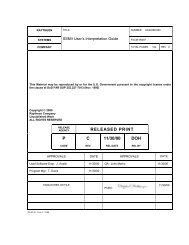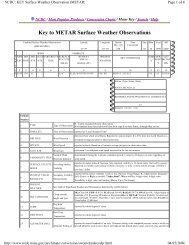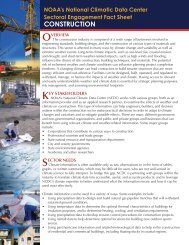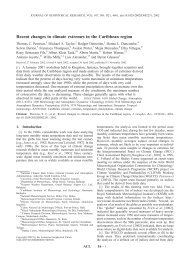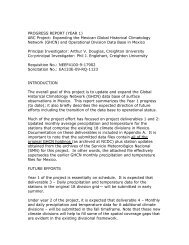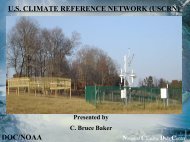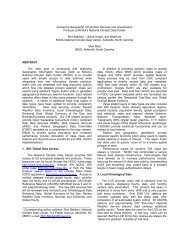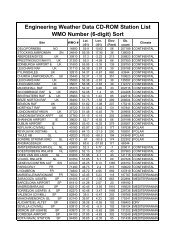Climatological Station History - National Climatic Data Center - NOAA
Climatological Station History - National Climatic Data Center - NOAA
Climatological Station History - National Climatic Data Center - NOAA
You also want an ePaper? Increase the reach of your titles
YUMPU automatically turns print PDFs into web optimized ePapers that Google loves.
Mi 3 <strong>Climatological</strong> <strong>Station</strong> <strong>History</strong><br />
<strong>Data</strong>base: Architectural Techniques<br />
Jeff Arnfield<br />
<strong>National</strong> <strong>Climatic</strong> <strong>Data</strong> <strong>Center</strong><br />
Asheville, NC<br />
Jeff.Arnfield@noaa.gov<br />
Gary Shears<br />
Sherian Corporation<br />
Morgantown, WV
<strong>Station</strong> <strong>History</strong> Evolution at NCDC<br />
♦ Paper forms<br />
• Cumbersome, inaccessible, slow search<br />
♦ Operational lists<br />
• Application-specific, limited info, redundancy<br />
♦ S2K database<br />
• Few queries, limited info, limited access<br />
♦ SHIPS (<strong>Station</strong> <strong>History</strong> Production System)<br />
♦CliServ<br />
• Slow, few queries, most access via a few<br />
reports, no query-only, design not normalized<br />
• Queryable, integrates limited station info &<br />
inventories from other systems
Mi 3 Background & Goals<br />
♦ Metadata Integration & Improvement Initiative<br />
♦ Integrate, enhance & increase access<br />
♦ Initial focus: system to manage NCDC’s<br />
climatological station history<br />
♦ Accommodate broad variety of station details<br />
• Identity<br />
• Location<br />
• Location Mapping<br />
• Instrumentation<br />
• Observing practices<br />
• <strong>Data</strong> Programs<br />
• Management<br />
• Photos & Document images<br />
♦ Track information source & log changes<br />
♦ Adapt to new observing systems, data<br />
programs and phenomena without recoding
Mi 3 System Overview<br />
♦ Normalized Oracle relational database<br />
• More than 140 tables<br />
• Accommodates new networks, programs and phenomena<br />
• Easily accessible by other apps & systems<br />
♦ Web-based delivery<br />
• ColdFusion, Java and PL/SQL<br />
• Geographically distributed access<br />
• Minimizes administration and training<br />
♦ Dedicated database and application servers<br />
• Excellent performance, even with ad hoc queries<br />
• Readily scaleable<br />
• Layered security and access
Temporal Trepidations<br />
♦ The Issues<br />
– All station details have a period of validity<br />
– Any station detail may change independently<br />
– Various station details often have different periods<br />
of validity<br />
– Relational design spreads details across many<br />
tables<br />
– Some tables may contain no details for a station<br />
for a given period<br />
♦ These factors can conspire to make a system<br />
an almost query-proof “metadata motel”<br />
♦ Managing and querying temporal information<br />
becomes critical to usability
Temporal <strong>Data</strong> Management<br />
♦ Possible Solutions<br />
– Create a new record in all tables whenever<br />
a station’s data changes in any table<br />
– Straight programmatic approach to<br />
combining data for each desired view<br />
– Develop a generalized, data-driven<br />
approach at the database level
So you want some station information….<br />
STATION NAME, COOP ID, TIME OF TEMP AND<br />
PRECIP OBSERVATION<br />
Begin Date End Date <strong>Station</strong> Name Coop ID Temp<br />
Prcp<br />
Obs<br />
Obs<br />
07/01/1930 09/15/1940 HAINES 503495 ? ?<br />
10/01/1940 09/15/1953 HAINES CAA 503495 ? ?<br />
09/15/1953 09/30/1956 HAINES 1 S 503492 ? ?<br />
09/06/1963 05/15/1968 HAINES ? ?<br />
06/21/1973 01/01/1984 HAINES 503490 1600 1600<br />
01/01/1984 04/01/1984 HAINES 503490 0800 0800<br />
04/01/1984 04/15/1986 HAINES 503490 0830 0830<br />
04/15/1986 07/01/1986 HAINES 503490 1500 1500<br />
07/01/1986 06/05/1998 HAINES 503490 0900 1500<br />
06/05/1998 12/31/9999 HAINES AIRPORT 503490 0900 1500
Three tables must be combined<br />
STATION NAME<br />
<strong>Station</strong> Key Begin Date End Date Name<br />
20021913 07/01/1930 10/01/1940 HAINES<br />
20021913 10/01/1940 09/15/1953 HAINES CAA<br />
20021913 09/15/1953 09/30/1956 HAINES 1 S<br />
20021913 09/06/1963 05/15/1968 HAINES<br />
20021913 06/21/1973 06/05/1998 HAINES<br />
20021913 06/05/1998 12/31/9999 HAINES AIRPORT<br />
•Join on <strong>Station</strong> Key column<br />
•Must also match by date<br />
•<strong>Data</strong> change<br />
independently<br />
•No table contains<br />
all dates<br />
STATION ID<br />
<strong>Station</strong> Key Begin Date End Date ID Type ID<br />
20021913 07/01/1930 09/15/1953 Coop number 503495<br />
20021913 09/15/1953 09/30/1956 Coop number 503492<br />
20021913 06/21/1973 12/31/9999 Coop number 503490<br />
20021913 07/01/1930 09/30/1953 WBAN number 25323<br />
20021913 09/06/1963 05/15/1968 WBAN number 25323<br />
20021913 06/21/1973 12/31/9999 WBAN number 25323<br />
<strong>Station</strong> Phenomenon Observing Protocol<br />
<strong>Station</strong> Key Begin Date End Date Phenomenon Frequency Obs Time<br />
20021913 06/21/1973 01/01/1984 TEMP Daily 1600<br />
20021913 01/01/1984 04/01/1984 TEMP Daily 0800<br />
20021913 04/01/1984 04/15/1986 TEMP Daily 0830<br />
20021913 04/15/1986 07/01/1986 TEMP Daily 1500<br />
20021913 07/01/1986 12/31/9999 TEMP Daily 0900<br />
20021913 06/21/1973 01/01/1984 PRCP Daily 1600<br />
20021913 01/01/1984 04/01/1984 PRCP Daily 0800<br />
20021913 04/01/1984 04/15/1986 PRCP Daily 0830<br />
20021913 04/15/1986 12/31/9999 PRCP Daily 1500<br />
•A table may not<br />
contain data for a<br />
given period
How do we derive the date pairs?<br />
01/01/1925<br />
09/15/1940<br />
09/15/1953<br />
09/30/1956<br />
09/06/1963<br />
05/15/1968<br />
06/21/1973<br />
01/01/1984<br />
04/01/1984<br />
04/15/1986<br />
07/01/1986<br />
06/05/1998<br />
12/31/9999<br />
Build a list of dates<br />
from all tables in the<br />
view, discarding<br />
duplicates<br />
STATION NAME<br />
<strong>Station</strong> Key Begin Date End Date Name<br />
20021913 07/01/1930 10/01/1940 HAINES<br />
20021913 10/01/1940 09/15/1953 HAINES CAA<br />
20021913 09/15/1953 09/30/1956 HAINES 1 S<br />
20021913 09/06/1963 05/15/1968 HAINES<br />
20021913 06/21/1973 06/05/1998 HAINES<br />
20021913 06/05/1998 12/31/9999 HAINES AIRPORT<br />
STATION ID<br />
<strong>Station</strong> Key Begin Date End Date ID Type ID<br />
20021913 07/01/1930 09/15/1953 Coop number 503495<br />
20021913 09/15/1953 09/30/1956 Coop number 503492<br />
20021913 06/21/1973 12/31/9999 Coop number 503490<br />
20021913 07/01/1930 09/30/1953 WBAN number 25323<br />
20021913 09/06/1963 05/15/1968 WBAN number 25323<br />
20021913 06/21/1973 12/31/9999 WBAN number 25323<br />
<strong>Station</strong> Phenomenon Observing Protocol<br />
<strong>Station</strong> Key Begin Date End Date Phenomenon Frequency Obs Time<br />
20021913 07/01/1930 09/30/1956 TEMP Daily<br />
20021913 06/21/1973 01/01/1984 TEMP Daily 1600<br />
20021913 01/01/1984 04/01/1984 TEMP Daily 0800<br />
20021913 04/01/1984 04/15/1986 TEMP Daily 0830<br />
20021913 04/15/1986 07/01/1986 TEMP Daily 1500<br />
20021913 07/01/1986 12/31/9999 TEMP Daily 0900<br />
20021913 07/01/1930 09/30/1956 PRCP Daily<br />
20021913 06/21/1973 01/01/1984 PRCP Daily 1600<br />
20021913 01/01/1984 04/01/1984 PRCP Daily 0800<br />
20021913 04/01/1984 04/15/1986 PRCP Daily 0830<br />
20021913 04/15/1986 12/31/9999 PRCP Daily 1500
The Context Date Pair Algorithm<br />
All Dates<br />
07/01/1930<br />
09/15/1940<br />
09/15/1953<br />
09/30/1956<br />
09/06/1963<br />
05/15/1968<br />
06/21/1973<br />
01/01/1984<br />
04/01/1984<br />
04/15/1986<br />
07/01/1986<br />
06/05/1998<br />
12/31/9999<br />
Begin Date End Date<br />
07/01/1930 10/01/1940<br />
10/01/1940 09/15/1953<br />
09/15/1953 09/30/1956<br />
09/30/1956 09/06/1963<br />
09/06/1963 05/15/1968<br />
05/15/1968 06/21/1973<br />
06/21/1973 01/01/1984<br />
01/01/1984 04/01/1984<br />
04/01/1984 04/15/1986<br />
04/15/1986 07/01/1986<br />
07/01/1986 06/05/1998<br />
06/05/1998 12/31/9999<br />
12/31/9999<br />
Begin Date End Date<br />
07/01/1930 10/01/1940<br />
10/01/1940 09/15/1953<br />
09/15/1953 09/30/1956<br />
09/06/1963 05/15/1968<br />
06/21/1973 01/01/1984<br />
01/01/1984 04/01/1984<br />
04/01/1984 04/15/1986<br />
04/15/1986 07/01/1986<br />
07/01/1986 06/05/1998<br />
06/05/1998 12/31/9999<br />
Use list to build date pairs,<br />
removing those pairs for<br />
which no table in the view<br />
contains data<br />
The final date pairs are used to<br />
drive the joins in our output<br />
view query
Context Date Pairs<br />
♦ “Context”, because a set of date pairs is valid<br />
in a specific context… a given view or report<br />
♦ Original 3-D implementation via Oracle views<br />
– Dang, this works!<br />
– Dang, this is slow<br />
– Dang, this is going to mean a lot of maintenance<br />
♦ Production implementation<br />
– Supporting functions implemented via PL/SQL<br />
stored procedures<br />
– Five table schema<br />
– Triggers ensure date pairs refreshed
The Context Date Pair Schema<br />
STATION<br />
STATION ID<br />
NUMBER(16)<br />
<br />
MODIFIED BY<br />
VARCHAR2(100)<br />
MODIFIED DATE<br />
DATE<br />
STN_CTXT_FK2_STN<br />
ENTERED DATE<br />
ENTERED BY<br />
DATE<br />
VARCHAR2(100)<br />
END DATE<br />
DATE<br />
BEGIN DATE<br />
DATE<br />
STATION CHRONOLOGY CONTEXT<br />
STATION ID<br />
CONTEXT ID<br />
BUILD DATE<br />
NUMBER(16)<br />
NUMBER(16)<br />
DATE<br />
<br />
<br />
STN_CTXT_FK2_CTXT<br />
CHRONOLOGY CONTEXT<br />
CONTEXT ID NUMBER(16)<br />
CONTEXT NAME VARCHAR2(100)<br />
OWNER VARCHAR2(30)<br />
DATE CREATED DATE<br />
<br />
PRIVATE FLAG<br />
NUMBER(1)<br />
SYSTEM FLAG<br />
NUMBER(1)<br />
STN_CHRON_FK2_STN_CTXT<br />
STATION CHRONOLOGY<br />
STATION ID NUMBER(16) <br />
CONTEXT ID<br />
NUMBER(16)<br />
<br />
END DATE<br />
BEGIN DATE<br />
DATE<br />
DATE<br />
CTXT_TBL_FK2_CTXT<br />
CONTEXT TABLE ROW TYPE<br />
CONTEXT ID<br />
TYPE COLUMN<br />
TYPE VALUE<br />
NUMBER(16)<br />
VARCHAR2(30)<br />
VARCHAR2(100)<br />
<br />
ROW_TP_FK2_CTXT_TBL<br />
CONTEXT TABLE<br />
CONTEXT ID NUMBER(16)<br />
TABLE NAME VARCHAR2(30)<br />
Context Date Schema in Action<br />
Chronology Context<br />
Context ID Context Name Owner Private System<br />
1 VU_NameCoopTempPrcpTOBS JARNFIEL N N<br />
2 VU_<strong>Station</strong><strong>History</strong>Overview MI3 N Y<br />
Context Table<br />
Context ID Table Name<br />
1 <strong>Station</strong> Name<br />
1 <strong>Station</strong> ID<br />
1 <strong>Station</strong> Phenomenon Observing Protocol<br />
Context Table Row Type<br />
Context Table Name<br />
Type Column Value<br />
ID<br />
1 <strong>Station</strong> ID ID TYPE COOP Number<br />
1 <strong>Station</strong> Phenomenon Observing Protocol Phenomenon TEMP<br />
1 <strong>Station</strong> Phenomenon Observing Protocol Phenomenon PRCP<br />
<strong>Station</strong> Chronology Context<br />
Context ID <strong>Station</strong> Key Build Date<br />
1 20021913 1/9/2002<br />
1 20000233 1/2/2002<br />
2 20021913 1/2/2002<br />
<strong>Station</strong> Chronology<br />
Context ID <strong>Station</strong> Key Begin Date End Date<br />
1 20021913 07/01/1930 10/01/1940<br />
1 20021913 10/01/1940 09/15/1953<br />
1 20021913 09/15/1953 09/30/1956<br />
1 20021913 09/06/1963 05/15/1968<br />
1 20021913 06/21/1973 01/01/1984<br />
1 20021913 01/01/1984 04/01/1984<br />
1 20021913 04/01/1984 04/15/1986<br />
1 20021913 04/15/1986 07/01/1986<br />
1 20021913 07/01/1986 06/05/1998<br />
1 20021913 06/05/1998 12/31/9999
Context Date System Implementation<br />
♦ Supporting Functions<br />
– Define & maintain a context via user interface<br />
– Rebuild a context for one station<br />
– Core logic, called by all rebuild functions<br />
– Rebuild a context for all stations<br />
– Rebuild all contexts for one station<br />
– Rebuild all contexts for all stations<br />
♦ Maintenance Performance<br />
– Building a single context containing 6 tables for<br />
35,000 stations takes less than 15 seconds,<br />
before tuning<br />
– Single station rebuild nearly instantaneous
Context Date Pair Benefits<br />
♦ Common schema / body of code<br />
– supports all queries, views and reports<br />
– minimizes maintenance<br />
– permits future enhancements<br />
♦ Critical in developing this system<br />
♦ Useful to power users for ad hoc queries<br />
♦ End-users benefit because special data<br />
requests are easier to accommodate
Mi3: Architectural Techniques<br />
♦ Credit where it’s due<br />
– David Bowman, of NCDC, laid logical groundwork<br />
for this algorithm while developing the Master<br />
<strong>Station</strong> <strong>History</strong> Report<br />
– Robin Ilardi, of Sherian Corp, developed code to<br />
implement the algorithm<br />
♦ For more information<br />
– Jeff.Arnfield@noaa.gov<br />
– Come to the NCDC portion of <strong>NOAA</strong>’s booth<br />
– NCDC’s web site: http://www.ncdc.noaa.gov



